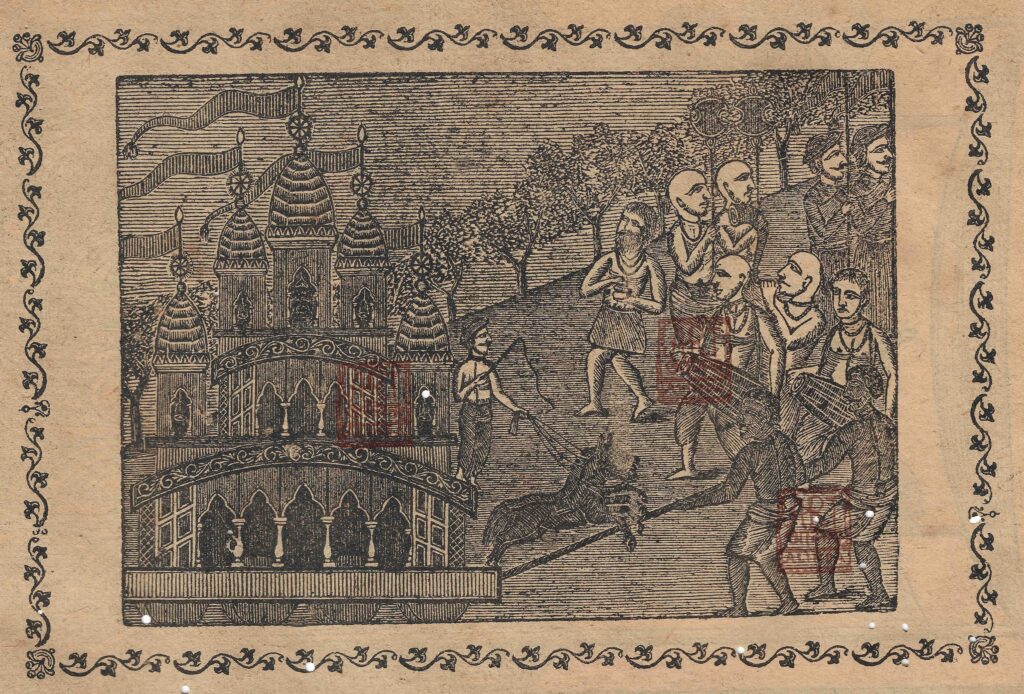
The significance of Rathayatra in Bengal:
Rathayatra, meaning “chariot procession,” is a festival deeply rooted in Hindu mythology and worship. It celebrates the divine journey of Lord Jagannath, accompanied by his siblings Balabhadra and Subhadra, in lavishly adorned chariots. In Bengal, Rathayatra holds immense significance, particularly in the cities of Kolkata, Puri, and several other towns and villages. It symbolizes the joyous union of the deities with their devotees and promotes unity, devotion, and spiritual enlightenment.
Community Participation and Festive preparations:
The late 19th century Rathayatra celebrations in Bengal were marked by enthusiastic community participation and elaborate preparations. Months before the event, various committees and organizations would come together to plan and organize the festivities. Communities would build intricately crafted chariots, known as “raths,” using traditional methods and materials, such as wood, ropes, and fabric. Skilled artisans and craftsmen would painstakingly decorate the raths with colorful fabrics, flowers, and traditional motifs, creating a visual spectacle that captured the imagination of all.
Procession and Devotion:
On the day of Rathayatra, the streets of Bengal would come alive with devotees and onlookers eagerly awaiting the grand procession. The raths, accompanied by devotees chanting hymns and singing devotional songs, would be pulled through the streets with great reverence and enthusiasm. The air would be filled with the fragrance of incense, the beat of drums, and the resonating sounds of conch shells, creating a vibrant atmosphere charged with devotion and spiritual energy.
Cultural Extravaganza and Artistic Expressions:
The late 19th century Rathayatra celebrations in Bengal were not just religious events but also cultural extravaganzas. The festival provided a platform for artists, musicians, dancers, and performers to showcase their talents. Elaborate cultural programs, including traditional music and dance performances, were organized to entertain the crowds and celebrate the region’s rich artistic heritage. The festivities became a melting pot of different art forms, fostering a sense of communal harmony and cultural exchange.
Social Harmony and Unity:
One remarkable aspect of the late 19th century Rathayatra celebrations in Bengal was the spirit of social harmony and unity that prevailed. People from all walks of life, irrespective of their religious or social backgrounds, actively participated in the festivities. The event became a symbol of communal integration and mutual respect, transcending barriers and fostering a sense of unity among diverse communities.
Legacy and Contemporary Relevance:
The late 19th century Rathayatra celebrations in Bengal left an indelible mark on the region’s cultural landscape. They shaped the collective memory of the people and continue to influence contemporary celebrations to this day. The grandeur, devotion, and artistic expressions witnessed during this era serve as a reminder of Bengal’s cultural richness and its ability to preserve and celebrate its traditions amidst changing times.
In conclusion, the late 19th century Rathayatra celebrations in Bengal were a time of immense cultural significance and communal harmony. These grand festivities, with their elaborate chariots, vibrant decorations, and artistic expressions, showcased the region’s rich heritage and religious devotion. The celebration of Rathayatra in Bengal has continued to evolve over time, incorporating modern elements while preserving its traditional essence. Today, the festival thrives as a celebration of spirituality, cultural diversity, and social unity.
